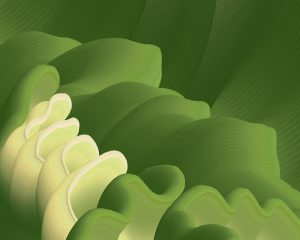My ten year journey exploring the power of generative and algorithmic processes
I approach sketching as I suppose composers would approach music composition. We know the general feeling we want to achieve, but the whole composition is not completed until each sequence has been tried and tested.
Following this process, I make a series of choices and pass these on to my computer. This sets the necessary parameters in the computer’s memory. The initial decision is choosing the instruments to use as my brushes. Sometimes these already exist in my library. If not, new ones may need to be drawn or photographed. I choose colors and symbols that reflect my intentions of the composition.

Next, I define the rhythm. Should the brush play on its own or should I pair it with another, switching constantly from one to the other, creating a more complex effect?
Then I select the beat, the speed of how closely each image is placed to the last. If images are placed very close together, all the will be seen is the edge of the “instrument”, giving a more three-dimensional effect. Spaced farther and farther apart, more of the whole “instrument” becomes visible.


Join me. Let’s set the cadence. Will the path of the images be smooth or jumbled?


And what about adding a tumble?

Finally, let’s set the dynamic range. Are all the images to appear the same size or should there be a horizon that creates a sense of perspective?

And now we compose. Each sequence of images is placed on the canvas, reviewed and either accepted or rejected and erased for another attempt. Parameters are modified. As layers are added the composition emerges. The final result is sometimes predicable. More often it’s a complete surprise. And, of course, most of the time the final result is scraped and I move on to a new attempt.
Once a new composition is accepted, it is time to make it print-worthy. A composition created on a monitor can be very crude because of the limited grid of pixels. Fortunately, the computer remembers the DNA of the composition. Each image, its size, position and angle is remembered. There can be thousands of lines.
| 1 | 1 | 157037 | 528703 | 508264 | 508264 | -2550728 | 1 |
| 2 | 1 | 172003 | 514424 | 353553 | 353553 | -2508188 | 1 |
| 3 | 1 | 187362 | 503121 | 158113 | 158113 | -2470163 | 1 |
| 4 | 1 | 201213 | 495738 | 204124 | 204124 | -2437646 | 1 |
| 5 | 1 | 214698 | 488026 | 329140 | 329140 | -2405250 | 1 |
| 6 | 1 | 229598 | 480843 | 418329 | 418329 | -2369317 | 1 |
| 7 | 1 | 243740 | 474032 | 491595 | 491595 | -2332199 | 1 |
| 8 | 1 | 257855 | 467637 | 540061 | 540061 | -2297916 | 1 |
| 9 | 1 | 273395 | 463460 | 577350 | 577350 | -2260784 | 1 |
| 10 | 1 | 288255 | 462772 | 584522 | 584522 | -2228685 | 1 |
| 11 | 1 | 302254 | 464315 | 570087 | 570087 | -2200346 | 1 |
| 12 | 1 | 316340 | 465838 | 555277 | 555277 | -2170480 | 1 |
| 13 | 1 | 331449 | 466306 | 555277 | 555277 | -2134880 | 1 |
The stored sequence allows the image to be redrawn at a higher quality in the memory of the computer, insuring at lease 300 pixels per inch. It can also be run with slightly modified colors or symbols creating new compositions


The Artist’s Statement
I judge what I love by the sketches I produce. Color! And color gradients that add a sense of dimensionality. Hard edges that define the individual elements, that add rhythm and sequence to the composition. And a process that allows reproducibility and refinement. A process that can create a type of perfection and precision in the final work.
Rob Morgan